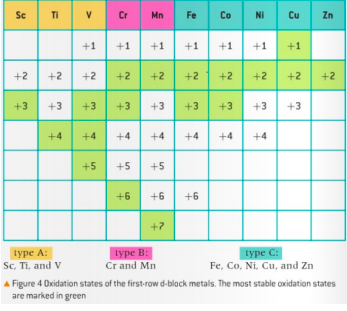3.1F Transition Metals
1/6
Earn XP
Description and Tags
Name | Mastery | Learn | Test | Matching | Spaced |
|---|
No study sessions yet.
7 Terms
What is the definition of a transition metal? Where are they found?
an element whose atoms have incomplete d-sublevels or that can give rise to cations with incomplete d-sublevels
They are found in the d-block of the periodic table.
What metal is NOT considered a transition metal despite its placement? Why?
Zinc becuase its d-oribitals are filled: [Ar]4s²3d¹⁰
Variable Oxidation States of Transition Metals

What are complexes? What surrounds what? What is the relationship between ligands and d-orbitals?
the combination of a transition metal and ligands
Central transition metal ion is surrounded by ligands
Ligands have a lone pair of electrons. They can make co-ordinate covalent bonds with the transition metal ion
Ligands split d-orbitals
How are complexes affected by light?
When light is shone on the complex, light of a particular wavelength is absorbed as an electron is promoted. The colour that we see is white light minus whatever colour is absorbed.
Transition metal speed up the reaction of chemical reactions being used. This means they are…?
catalysts
Why are transition metals magnetic?
Magnetic strength depends on the number of unpaired electrons in the d-orbitals
